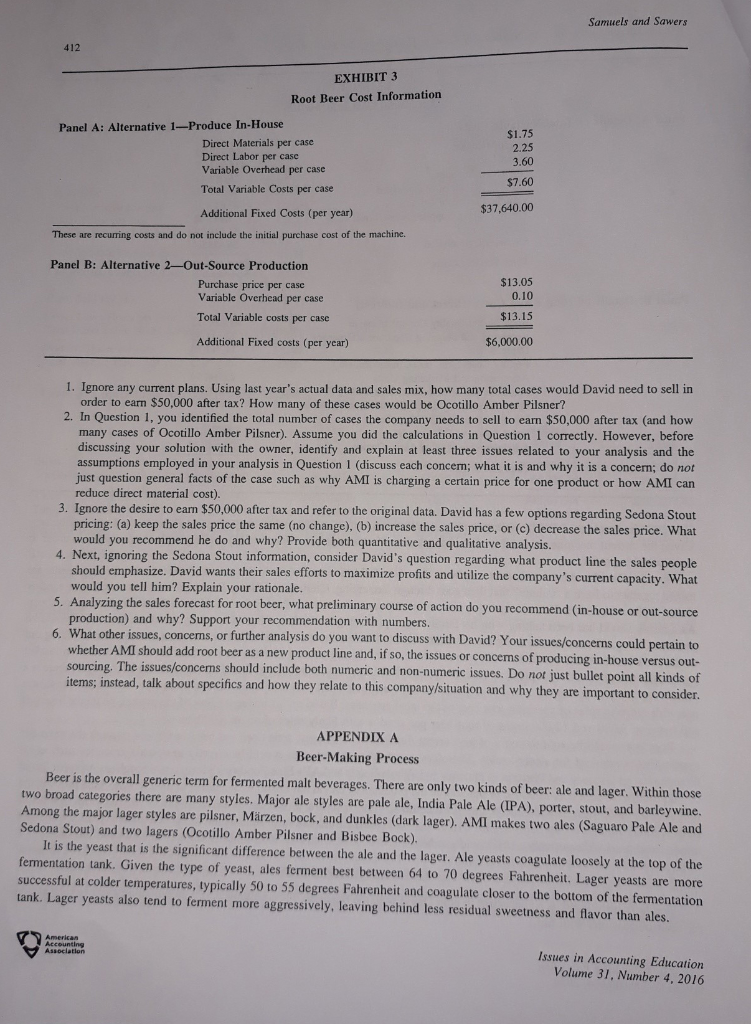Look at Question: Microbrewery, Inc.: An Instructional Case on Management has the additional information on page . Pg. 413. I could not post another image here.

Samuels and Sawers EXHIBIT 3 Root Beer Cost Information Panel A: Alternative 1-Produce In-House $1.75 2.25 3.60 Direct Materials per case Direct Labor per case Variable Overhead per case $7.60 Total Variable Costs per case $37,640.00 Additional Fixed Costs (per year) These are recurring costs and do not include the initial purchase cost of the machine. Panel B: Alternative 2-Out-Source Production $13.05 Purchase price per case 0.10 $13.15 $6,000.00 Variable Overhead per case Total Variable costs per case Additional Fixed costs (per year) t. Ignore any current plans. Using last year's actual data and sales mix, how many total cases would David need to sell in order to earn $50,000 after tax? How many of these cases would be Ocotillo Amber Pilsner? 2. In Question 1, you identified the total number of cases the company needs to sell to earn $50,000 after tax (and how many cases of Ocotillo Amber Pilsner). Assume you did the calculations in Question 1 correctly. However, before discussing your solution with the owner, identify and explain at least three issues related to your analysis and the assumptions employed in your analysis in Question 1 (discuss each concern; what it is and why it is a concern; do no just question general facts of the case such as why AMI is charging a certain price for one product or how AMI can reduce direct material cost) pricing: (a) keep the sales price the same (no change), (b) increase the sales price, or (c) decrease the sales price. What would you recommend he do and why? Provide both quantitative and qualitative analysis 4. Next, ignoring the Sedona Stout information, consider David's question regarding what product line the sales people ld emphasize. David wants their sales efforts to maximize profits and utilize the company's current capacity. What would you tell him? Explain your rationale alyzing the sales forecast for root beer, what preliminary course of action do you recommend (in-house or out-source production) and why? Support your recommendation with numbers. 6. What other issues, concems, or further analysis do you want to discuss with David? Your issues/concerns pertain to should include both numeric and non-numeric issues. Do not just bullet point all kinds of whether AMI should add root beer as a new product l sourcirn line and, if so, the issues or concems of producing in-house versus out items; instead, talk about specifics and how they relate to this company/situation and why they are important toc APPENDIX A Beer-Making Process Beer is the overall generic term for fermented malt beverages. There are only two k two broad categories there are many styles. Major ale styles are pale ale inds of beer: ale and lager. Within those , India Pale Ale (IPA), porter, stout, and barleywine. Among the major lager styles are pilsner, Mrzen, bock, and dunkles (dark lager). AMI makes two ales (Saguaro Pale Ale and Sedona Stout) and two lagers (Ocotillo Amber Pilsner and Bisbee Bock) It is the yeast that is the significant difference between the ale and the lager. Ale yeasts coagulate loosely at the top of the fermentation tank. Given the type of yeast, ales ferment best between 64 to 70 degrees Fahrenheit. Lager yeasts are more successful at colder temperatures, typically 50 to 55 degrees Fahrenheit and coagulate closer to the bottom of the fermentation tank. Lager yeasts also tend to ferment more aggressively, leaving behind less residual sweetness and flavor than ales Association Issues in Accounting Education Volume 31, Number 4, 2016 Samuels and Sawers EXHIBIT 3 Root Beer Cost Information Panel A: Alternative 1-Produce In-House $1.75 2.25 3.60 Direct Materials per case Direct Labor per case Variable Overhead per case $7.60 Total Variable Costs per case $37,640.00 Additional Fixed Costs (per year) These are recurring costs and do not include the initial purchase cost of the machine. Panel B: Alternative 2-Out-Source Production $13.05 Purchase price per case 0.10 $13.15 $6,000.00 Variable Overhead per case Total Variable costs per case Additional Fixed costs (per year) t. Ignore any current plans. Using last year's actual data and sales mix, how many total cases would David need to sell in order to earn $50,000 after tax? How many of these cases would be Ocotillo Amber Pilsner? 2. In Question 1, you identified the total number of cases the company needs to sell to earn $50,000 after tax (and how many cases of Ocotillo Amber Pilsner). Assume you did the calculations in Question 1 correctly. However, before discussing your solution with the owner, identify and explain at least three issues related to your analysis and the assumptions employed in your analysis in Question 1 (discuss each concern; what it is and why it is a concern; do no just question general facts of the case such as why AMI is charging a certain price for one product or how AMI can reduce direct material cost) pricing: (a) keep the sales price the same (no change), (b) increase the sales price, or (c) decrease the sales price. What would you recommend he do and why? Provide both quantitative and qualitative analysis 4. Next, ignoring the Sedona Stout information, consider David's question regarding what product line the sales people ld emphasize. David wants their sales efforts to maximize profits and utilize the company's current capacity. What would you tell him? Explain your rationale alyzing the sales forecast for root beer, what preliminary course of action do you recommend (in-house or out-source production) and why? Support your recommendation with numbers. 6. What other issues, concems, or further analysis do you want to discuss with David? Your issues/concerns pertain to should include both numeric and non-numeric issues. Do not just bullet point all kinds of whether AMI should add root beer as a new product l sourcirn line and, if so, the issues or concems of producing in-house versus out items; instead, talk about specifics and how they relate to this company/situation and why they are important toc APPENDIX A Beer-Making Process Beer is the overall generic term for fermented malt beverages. There are only two k two broad categories there are many styles. Major ale styles are pale ale inds of beer: ale and lager. Within those , India Pale Ale (IPA), porter, stout, and barleywine. Among the major lager styles are pilsner, Mrzen, bock, and dunkles (dark lager). AMI makes two ales (Saguaro Pale Ale and Sedona Stout) and two lagers (Ocotillo Amber Pilsner and Bisbee Bock) It is the yeast that is the significant difference between the ale and the lager. Ale yeasts coagulate loosely at the top of the fermentation tank. Given the type of yeast, ales ferment best between 64 to 70 degrees Fahrenheit. Lager yeasts are more successful at colder temperatures, typically 50 to 55 degrees Fahrenheit and coagulate closer to the bottom of the fermentation tank. Lager yeasts also tend to ferment more aggressively, leaving behind less residual sweetness and flavor than ales Association Issues in Accounting Education Volume 31, Number 4, 2016







